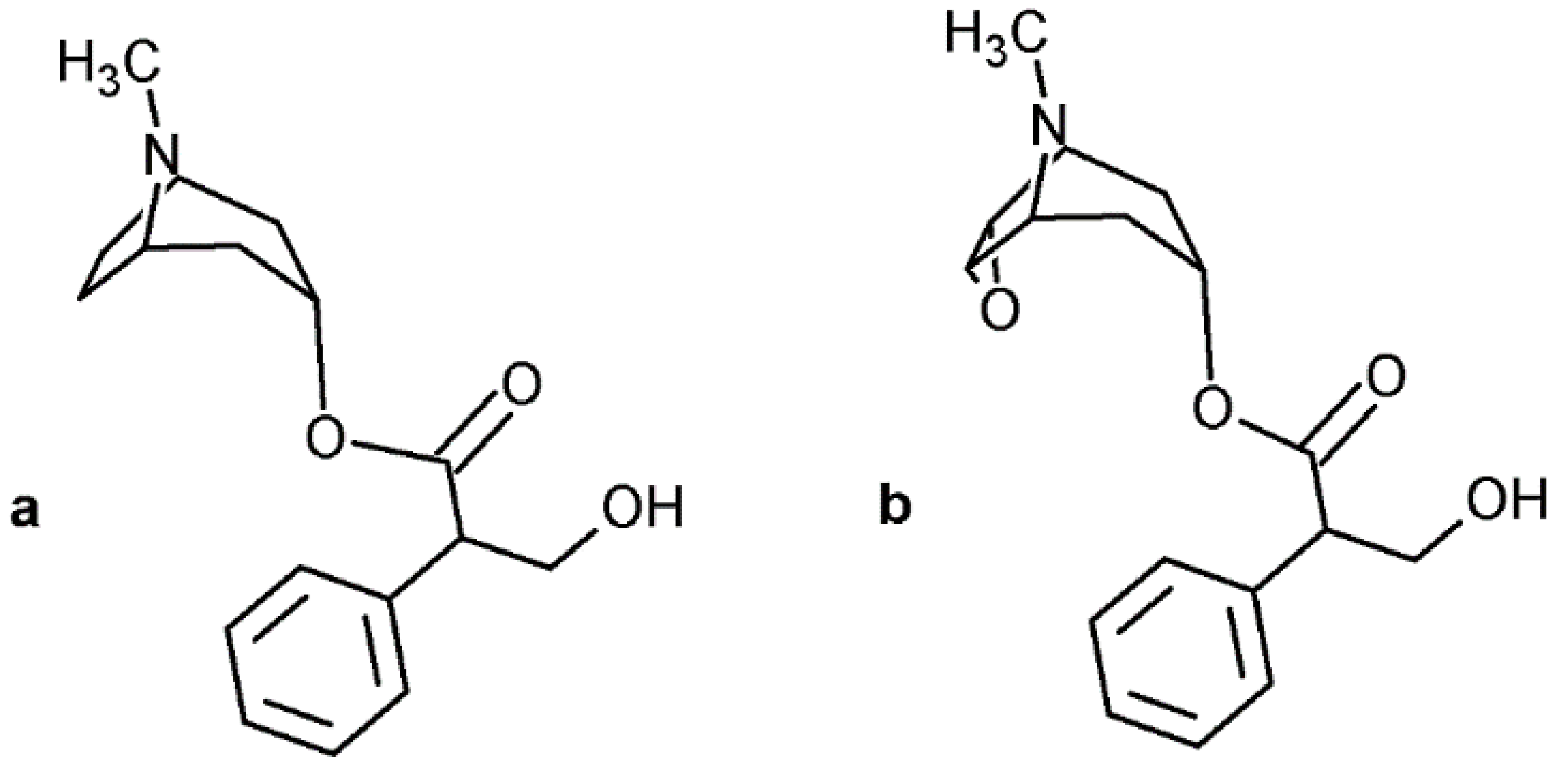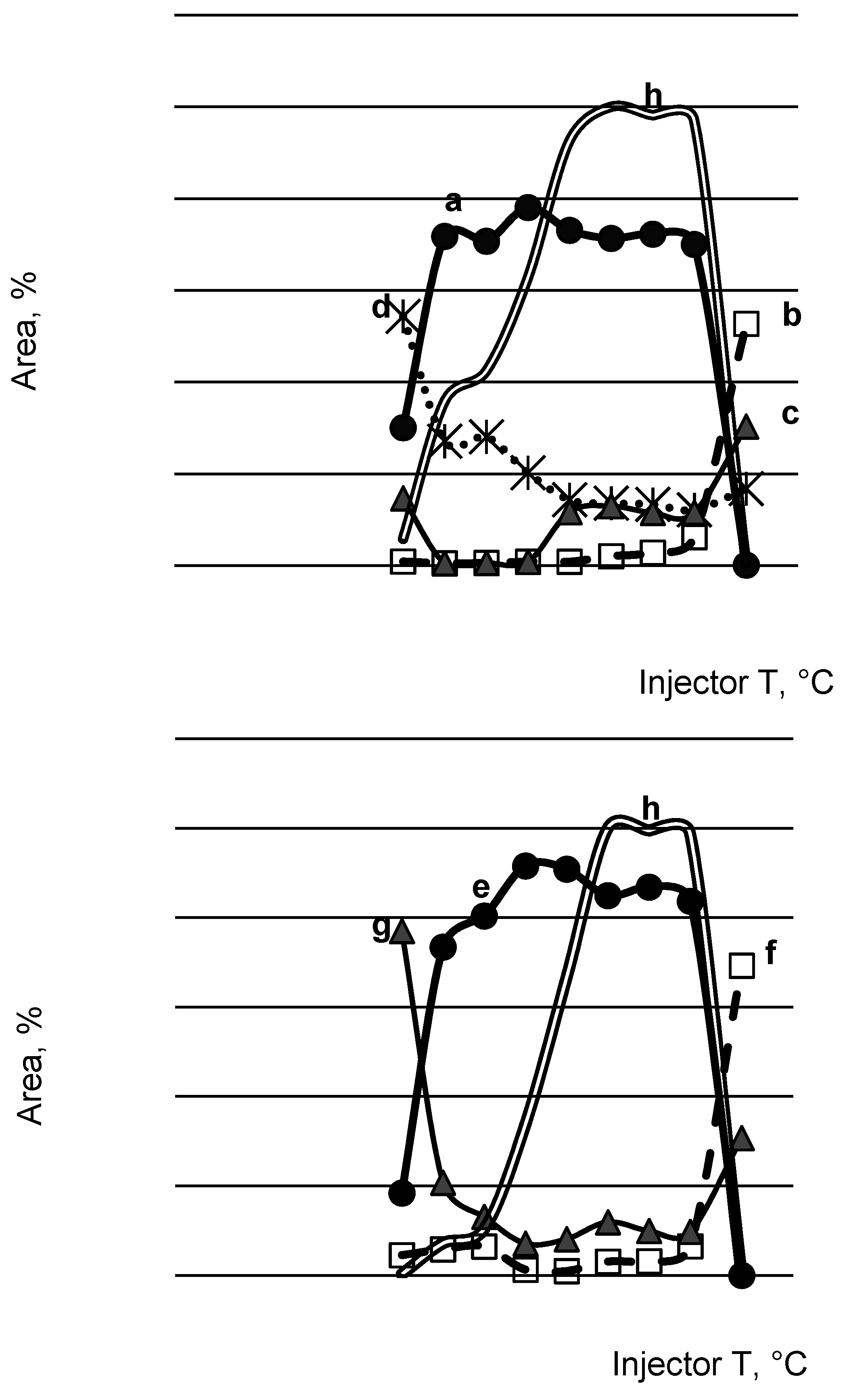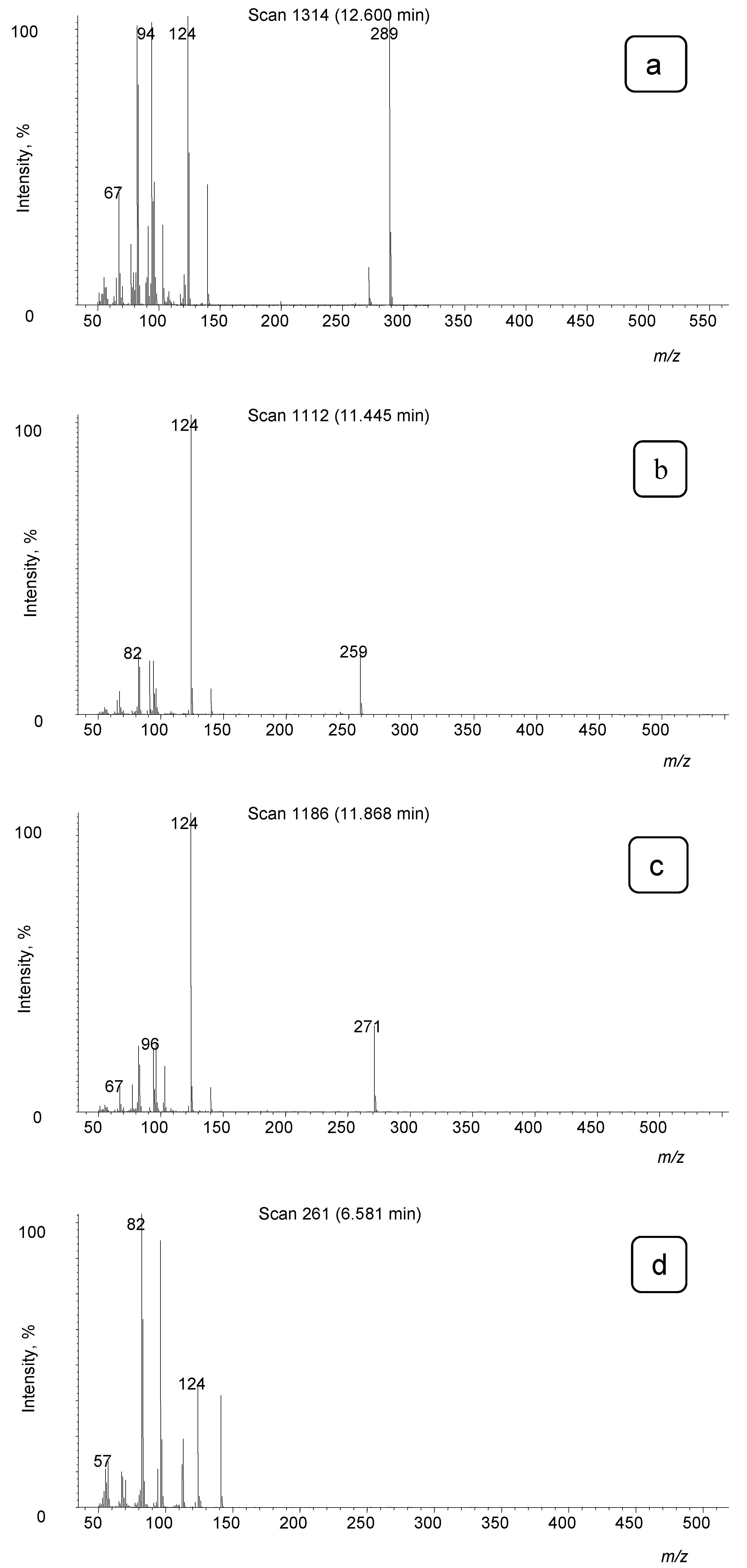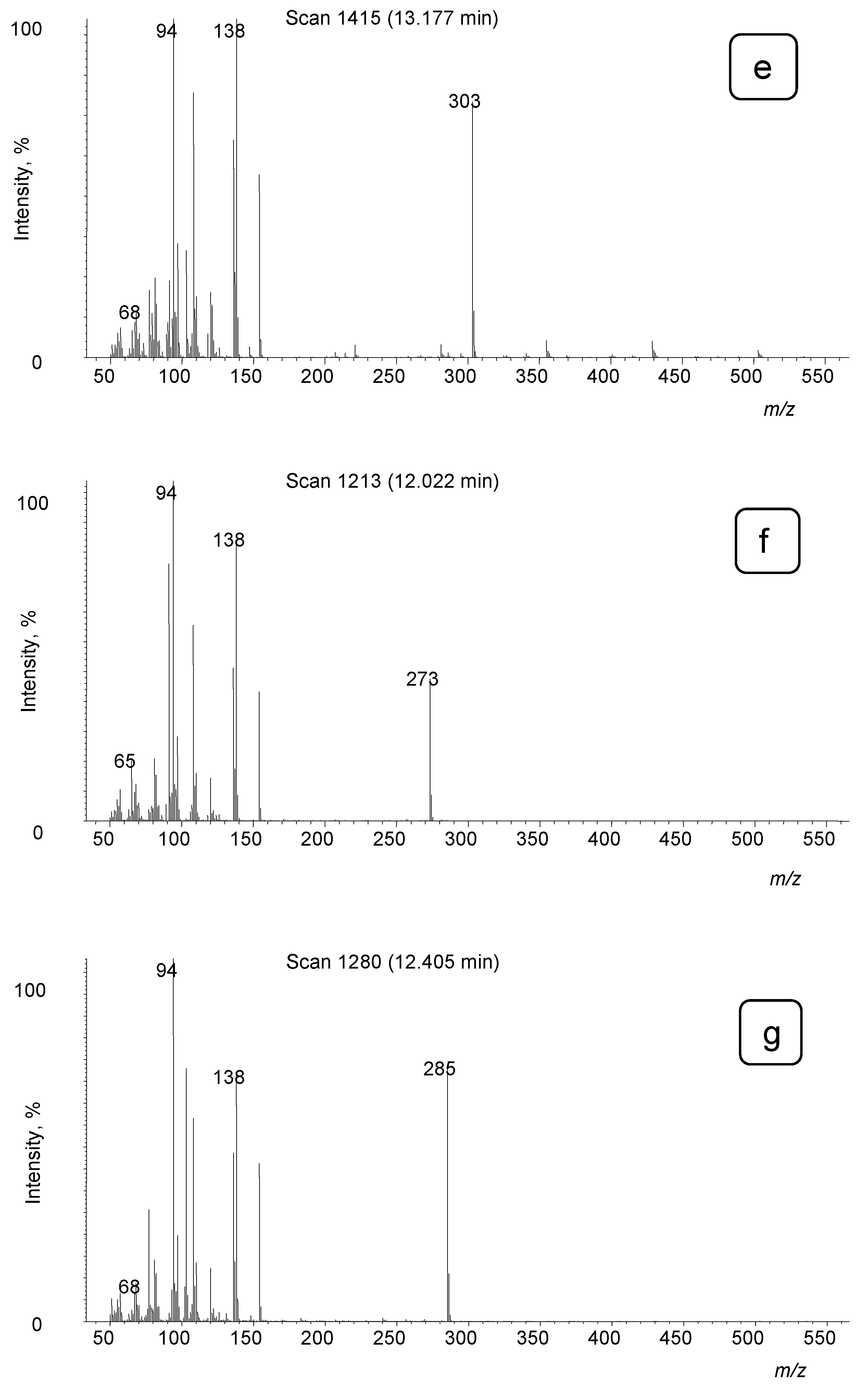3.1. Solutions of Atropine in Scopolamine in Different Solvents
In our practice, in the case of general unknown analysis, LLE or SPE extracts of biological samples are dissolved in methanol and afterwards, screened by the GC-MS method described in the Experimental
Section 2.2. Methanol, being both a proton donor and acceptor, is used as a solvent for a variety of substances that are efficiently dissolved despite their frequently quite different polarity. The sample is vaporized in the inlet and transferred to a column at a low initial temperature where condensation of solvent and sample occurs. As the temperature is increased, the methanol evaporates and the sample is preconcentrated in the residual solvent within a narrow area. Analytes are vaporized from this area at the beginning of the column at higher oven temperatures. However, a high temperature of the injector is used to vaporize less volatile substances. Because of this, the occurrence of thermal decomposition products, methylated substances, and formaldehyde adducts is possible. Several mass spectra of such compounds are included in commercial mass spectra libraries (e.g., Pfleger/Maurer/Weber, NIST) but are not necessarily marked as such, and the recognition of their origin depends on the analyst’s knowledge and experience. Thermolysis is noticeable in atropine and scopolamine, as illustrated in
Figure 2.
We were interested in the extent of thermal degradation at different conditions. Thus, the behavior of both substances in the solution with three solvents of different polarities was studied, with methanol being the most polar, less polar ethyl acetate, and
n-hexane as the nonpolar one. Tropanes were also exposed to different injector temperatures. As an example, only results for methanol as solvent are presented in
Figure 3, while additional results for other solvents are given in
Supplementary Materials, Figure S1 and Table S1. In the temperature range from 100 to 250 °C, the thermal energy is sufficient only for low-energy reactions such as functional group elimination at the end of the chain [
13]. In our case, this corresponds to elimination of water from the atropine and scopolamine molecules in the GC inlet and the cleavage of the ester bond, the latter observed only in atropine. Atropine is more degradable than scopolamine. The main structural difference lies in the cyclic ether bond, which could be the reason for increased degradability. In the temperature range from 250 to 500 °C, there is enough thermal energy to break the chemical bonds with the highest energy [
13]. Consequently, also the elimination of formaldehyde becomes important for tropanes at higher inlet temperatures. Successive elution of tropanes and their degradation products from the chromatographic column, corresponding to their specific physico-chemical properties, is proof of thermal degradation taking place in the inlet of a gas chromatograph. The corresponding mass spectra are presented in
Figure 4.
The degradation phenomena were more pronounced in methanol. With temperatures below 250 °C, the elimination of water was predominant compared to formaldehyde elimination. Both processes were comparable but proceeded to a negligible extent in ethyl acetate again up to 250 °C. At 275 °C, atropine and scopolamine were almost completely degraded both in methanol and ethyl acetate. In the case of n-hexane as the solvent, the situation was fully unpredictable, rendering different and randomly changing ratios of peak areas, with comparable areas for atropine, scopolamine, and their degradation products and giving poor response for parent compounds. Described observations could have arisen from the properties of the applied solvents, which contributed to the degradation process. The most pronounced influence was from methanol, being both a proton acceptor and donor, and less from ethyl acetate, which is only a proton acceptor. n-Hexane is neither a proton acceptor nor proton donor. Moreover, both analytes are poorly soluble in it. Low solubility could cause their wider dispersion upon entering the GC column (at 60 °C) and lower preconcentration at the beginning of the column, leading to higher exposure to heat and consequently, a higher relative amount of thermal decomposition products, which was actually observed. To summarize: Methanol as solvent caused the highest degree of degradation both at temperatures below or above 250 °C. Ethyl acetate promoted degradation only at temperatures above 250 °C, while for n-hexane, no behavioral pattern could be established.
In the next step, we wanted to investigate the influence of analyte concentration on the extent of thermal degradation. We chose the following experimental conditions: The solvent was ethyl acetate and not methanol with a more pronounced influence on degradation, the inlet temperature was lowered to 250 °C to preserve the majority of parent compounds. Results for the solutions with concentration 200 and 2 mg/L (hundred-times dilution) were compared with those obtained for the same solutions at inlet temperature 275 °C (
Table 1 and
Table 2). Atropine was significantly more degraded at the higher inlet temperature than scopolamine and additionally with dilution.
3.2. Application on Real Samples
The GC-MS method described in Experimental
Section 2.2 has been used in our laboratory for more than 25 years as a general screening method in forensic, clinical, DUI, and drugs of abuse cases. From the very beginning, we have used a lower inlet temperature of 275 °C compared to usually higher reported
T of screening procedures, for instance, 280 °C [
14]. The decision was based on observed degradations of some compounds (for example, oxazepam, ß-blockers) as well as on cases with problematic or even unsuccessful primary identification. Despite the analysis of several thousands of cases per year, atropine was present in a very small number of poisonings and scopolamine even in less. Some identification problems of atropine and scopolamine will be presented in the following case studies.
A young male was found irresponsive, hallucinating. After successful treatment in the hospital, he admitted taking tea prepared from thorn-apple (
Datura stramonium), containing atropine and scopolamine. GC-MS toxicological analysis of extracted urine confirmed the presence of both alkaloids and degradation products of scopolamine, namely scopolamine-H
2O and scopolamine-CH
2O. All compounds were reliably identified with a library search algorithm. Predominant chromatographic peaks were, in this case, degradation products of scopolamine, outstanding was scopolamine-H
2O presenting 78% of a sum of areas, while for scopolamine, it was only 2%. The peak area of atropine was small compared to scopolamine. Concentrations of parent compounds were subsequently determined with a validated LC-MS/MS method [
10]. The concentration of atropine in blood was 0.019 mg/L and in urine 0.30 mg/L, while concentrations of scopolamine were 0.011 and 0.95 mg/L, respectively.
A young male was treated in the hospital emergency department after drinking tea. The same GC-MS method was used as above for identification of toxic compounds in extract of urine sample and extract of tea sample. Library search hits for tea extract were acetylated homatropine, atropine-H2O, and acetylated atropine, the latter at a significantly inappropriate retention time. Based on the presence of atropine degradation products and heteroanamnestic data, typical mass fragments were extracted (m/z 84, 124, 289, 94, 138, and 303), leading to the confirmation of atropine and scopolamine as well as their degradation products formed by elimination of water and formaldehyde. Library search of mass spectra of peaks of urine extract gave only a hit for atropine-CH2O, probably due to high background, and no other toxicologically relevant compounds were identified. With the extraction of typical mass fragments from the recorded mass spectra, the presence of atropine, atropine-H2O and atropine-CH2O was confirmed (estimated percentage of the sum of areas were 33%, 7%, and 60%, respectively), as well as the presence of scopolamine, scopolamine-H2O, and scopolamine-CH2O (estimated percentage of the sum of areas were 64%, 16%, and 20%, respectively).
Buckwheat grain and flour (
Fagopyrum sp., Polygonaceae) have an important role in the national Slovenian cuisine. Among various traditional dishes, a dish named “ajdovi žganci” is very popular (translated in English as “buckwheat spoonbread”). In September 2003, a mass food poisoning accident with the symptoms of a classic anticholinergic syndrome occurred in Slovenia. The National Institute of Public Health of Slovenia established an
ad hoc self-reporting scheme and identified 73 cases with symptoms of tropane alkaloid toxicity. All intoxicated persons had consumed buckwheat flour food products within the last few hours. About 20 samples of disputable buckwheat products were analyzed by the presented GC-MS method after extraction of 30 g of material. All samples were dissolved in methanol and due to considerable amount of sample the presence of tropane alkaloids atropine and scopolamine was confirmed by library search. Degradation products of both compounds due to elimination of water and formaldehyde were identified after extraction of typical mass fragments from mass spectra, as well as traces of tropine. In the few delivered samples of blood and urine, tropanes or their degradation products were not identified. Further macroscopic examination of whole buckwheat grain revealed the presence of seeds of thorn-apple. At that time, temporary maximum residue levels (MRLs) of tropane alkaloids were established. To verify them, a study with volunteers was realized, and for that purpose, a validated LC-MS/MS method was developed [
10,
15].
GC-MS analyses of blood serum samples taken from patients at the intensive care unit occasionally reveal the presence of atropine and/or atropine-H2O in extracts as a result of medical treatment.
Although the predominant processes during thermal exposure of tropanes depend on experimental parameters, good repeatability of measurements cannot be expected, making the method inappropriate for quantitative purposes. On the other hand, the thermal degradation products can offer additional valuable information while identifying compounds in the case of a general unknown analysis. In our practice, most often, the presence of dehydrated atropine or scopolamine triggers further appropriate analyses for the confirmation of their parent compounds. Depending on other circumstances, especially if other toxicologically important substances are present, one of the following possibilities is selected for further analysis: Inlet temperature is set to 250 °C, acetylated products are additionally prepared and identified, or the LC-MS/MS method is applied.











